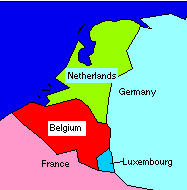|
|
 |
|
|
|
|
|
In England these were known as the Low Countries. (The Netherlands exists in the delta of the Rhine.) Their political origin is partly in the failed division of Lotharingia given to Lothar the third son of Charlemagne. They represent the interface between Germanic and Latin Europe, and later between the power of France and the Habsburg emperors. Belgium is divided between the Dutch (Flemish) speakers in the north and the French speakers of the south (Wallonia). Following the second world war the three small countries, which had all been occupied by the Germans, agreed to harmonize their currency, customs and economic policies - the three currencies were linked together at a fixed rate. Their experience was the basis on which the later European Communities were modeled. Luxembourg linked its franc directly to the Belgian franc. They formed a customs union. Benelux as an organization was dissolved on the signing of the Treaty of Rome in 1956 but the customs arrangements continued. In 1993 the Single Market extended the customs union to the whole EU. In 2002 all adopted the euro as their currency. The former COMECON countries of Poland, Czechs, Slovakia and Hungary began a similar arrangement with each other, but have subsequently joined the EU with a transition arrangement. |
